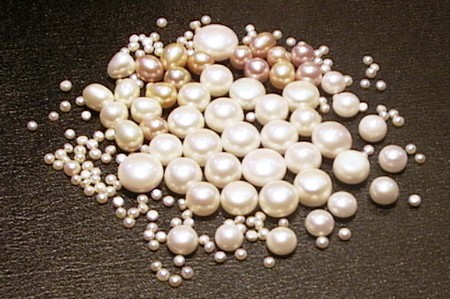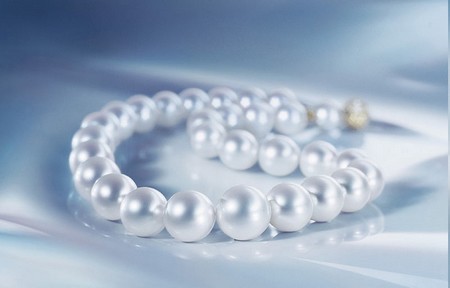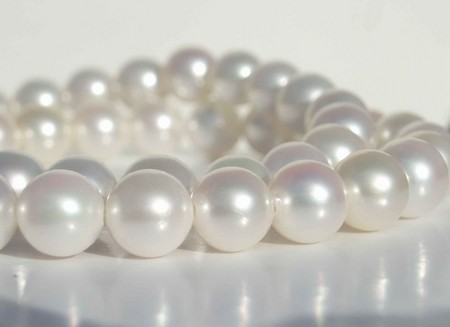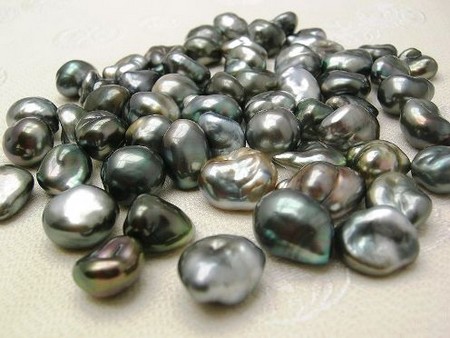There is a famous Arabic myth according to which pearls are shaped when dew drops fall into the ocean and swallowed by oysters. This is perhaps the courteous and impressive way to explain the process of formation of a pearl. However, scientific explanation is quite different from this mythical elucidation. Scientifically, when any foreign matter enters the shell of the mollusk and irritates it, mollusk covers the foreign particle with a chemical substance to avoid irritation. This chemical substance gradually transforms along with foreign matter into a smooth pear.
Pearls are not of single type. There are numerous known types of pearls. Each and every type of pearl is characterized by different ways and waters in which different types of pearls are developed or discovered. Following are given some of the types of pearls:
Natural Pearls
As the name suggests, these pearls are formed through a natural process. Natural pearls are known as the true pearls. These are formed when a foreign particle enters the shell of a mollusk and mollusk gets irritated with it. So, mollusk releases a particular type of chemical substance (calcium carbonate and conchiolin) to prevent this irritation. This chemical substance covers the foreign matter. This gradual production of chemical substance and its accumulation on the foreign matter eventually results in the creation of a pearl. Natural pearl can be of any shape. Having a round pearl is rare.
Cultured Pearls
Cultured pearls are types of pearls which are formed by raising the oysters and purposefully put a foreign matter inside the shell of mollusk. The foreign matter used in this regard is mostly bead. When a bead is placed in the shell of a mollusk, the pearl formed will get a shape of the bead. An X-ray can be used to differentiate the cultured pearls from other types of pearls. It is through X-ray that one can find the presence of bead placed in the shell. Although, the cultured pearl is also formed by natural process, the only difference between natural pearl and cultured pearl is the purposeful placement of bead in the shell of a mollusk in the latter type.
Freshwater Pearls
Freshwater pearls are the pearls which are formed in the shell of the oysters living in freshwaters, i.e. river, lake or ponds. It is said that more than twenty pearls can be formed from a single freshwater mollusk and one pearl takes almost 6 months to 2 years to get its final shape. With freshwater pearls relatively smaller-sized foreign matters are used. These pearls are rare and found in several different shapes. It is believed that freshwater pearls are more study and tough in contrast to saltwater pearls.
Saltwater Pearls
Unlike freshwater pearls, these pearls are formed from the oysters found in the saltwater such as ocean, bays, seas, and gulfs and also a single oyster can only form one pearl. The process of pearl formation in saltwater oyster takes over two years. Saltwater pearls are normally round in shape, less sturdy and have low resistant in contrast to freshwater pearls. However, saltwater pearls are costlier than freshwater pearls because of the higher cultivating cost of saltwater mollusks.
Akoya Pearls
These pearls are formed in the species Pinctada fucataoyster which is commonly found in the cool, temperate saltwater of Japan. China is known to the second largest in the production of akoya pearls. Akoya pearls are popular for their uniform mineral crystals having luminous sheen. It is considered as the shiniest pearl among all the other pearls. Normally, an akoya pearl takes it final form between eight to twenty-four months. However, the cultivators often wait for a little more time in a view to have a big pearl. Akoya pearl is normally available in the size range from 2-10 millimeter. The color of akoya pearls ranges from rose, silver/white, cream, gold to grey/blue.
South Sea Pearls
South Sea Pearls are formed in the shell of the species Pinctada maxima (the two varieties are known as the Silver Lipped and Gold Lipped Oysters). This species is common in the warm waters of Australia, Indonesia, Philippines, Thailand and Myanmar. The pearl formed in this species are larger in size and rarely found. South Sea pearls take almost twenty to twenty-four months before coming in its final form. These pearls can have a size of about 9-20 millimeter with an average size of 13 millimeter. South sea pearls are found in silver, silver/pink, white/gold, gold, white/pink and white colors.
Tahitian Pearls
The species Pinctada margaritifera cumingi oyster or the Black Lipped Oyster is accountable for the production of Tahitian pearls. It is widely available in the waters of French Polynesia. These pearls are very uncommon because of the fact that only 1 out of 10,000 oysters forms this pearl. It takes twenty-two to twenty-six months before a pearl gets its final shape. Tahitian pearls are usually 8-18 millimeter in size with an average size of 9-10 millimeter. However, the largest found Tahitian pearl was 25 millimeter in size. It is found in so many different color patterns such as aubergine (eggplant), peacock (the most common), black/green, black/black, black/blue, silver/grey, black/grey and black/rose.
Keshi Pearls
These pearls are considered as the consequence of the pearl culturing process. These are small in size and are formed when foreign matter enters in the shell and oyster covers it with nacre.
Mabe Pearls
Mabe pearls are the pearls which are formed when a plastic dome is fixed on the inner side of the shell of an oyster. Oyster wraps up the plastic dome with nacre. Once the formation process completed, the mabe is beheaded from the shell and the inner side is covered with plastic or any other such material to increase the weight. Finally, the mother of pearl are kept on the dorsal area of the mabe pearl.
Mother of the Pearl
Mother of the pearl is basically not a pearl in fact rather it is a kind of glossy coating found on the inner side of the shell of an oyster which is capable of forming a pearl. It is not found in all the oysters.
Above mentioned are some of the different types of pearls and it is obvious that the types of pearls are characterized in terms of the oyster species and nature of water where these oysters are raised.



